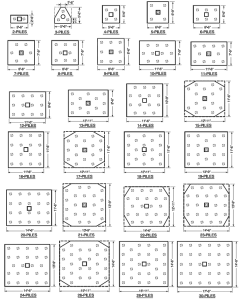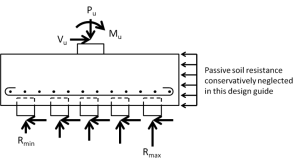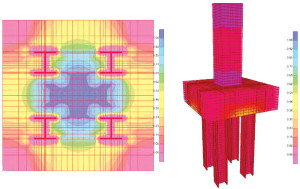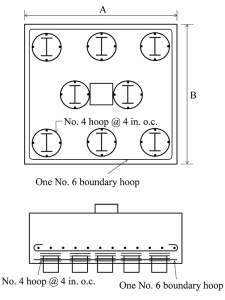Although pile caps are an important structural element, they are generally neglected in textbooks on structural design. This article is intended to offer a brief introduction to the new CRSI/DFI (Concrete Reinforcing Steel Institute/Deep Foundations Institute) Pile Cap Design Guide referred to henceforth as the Guide. The Guide was authored by Dr. Timothy W. Mays, P.E. with The Citadel.
The new Guide has been developed as a standalone publication to provide the practicing engineer with a detailed overview of pile cap design, detailing, and analysis methodologies that represent the current state of practice in the industry, and meet the latest codes and standards including the 2015 International Building Code (IBC) and ACI 318-14.
The Guide is much more than an updated version of Chapter 13 of the CRSI Design Handbook (2008). When the Design Handbook pile cap design tables were developed, pile allowable loads exceeding 200 tons were not common. The advent of new 16-inch and 18-inch HP sections with higher allowable loads has necessitated the need of an expanded scope that includes pile allowable loads up to 400 tons. Assuming a factor of safety of 2, this implies in place pile loads up to 800 tons. The Guide also features expanded design tables to account for the higher allowable loads.
The complex and often misunderstood load path fundamentals associated with pile caps, and the fact that most pile caps are not open to visual inspection under service, warrants a conservative design approach. Complete nonlinear finite element modeling of pile caps is not practical in routine design practice, and applying geometry specific strut-and-tie design models for all pile caps can actually be unconservative when certain modes of failure control the pile cap’s response. For this reason and others, ACI 318-14 does not permit strut-and-tie modeling for all pile caps. In fact, only “deep pile” caps may be designed by this approach.
The Guide provides an overview of load types considered and how these loads are appropriately combined to design pile caps, followed by an overview of assumptions used to determine the load distribution to piles when caps are subjected to different load cases. Thirty pile cap configurations with dimensioning requirements are considered in the Guide, and the overall recommended layout of steel reinforcement in the pile cap is also provided (Figure 1).

Figure 1. Arrangement of piles and minimum plan dimensions of pile caps.
Pile cap design procedures for vertical and lateral/overturning loads, respectively, are considered, along with a special chapter devoted to seismic design of pile caps. The Guide offers several practical pile cap design examples including complete manual solutions for vertical and lateral load situations as well as complimentary access to design spreadsheets.
Tabulated pile cap designs for both vertical loads and combined, vertical, lateral, and overturning actions are available for pile loads up to 400 tons allowable load. The appendices are also replete with practical information. Appendix A presents detailed derivations for several simplified design equations presented in the Guide. Column-to-pile cap and pile-to-pile cap connection details are discussed in Appendix B and C, respectively.

Figure 2. Pile cap resisting column applied axial, shear, and bending moment. Pile head assumed pinned.
Research performed during the development of this Guide suggests that deeper pile caps associated with larger and stronger piling than was considered in the Design Handbook warrant some new steel details. In addition, lateral loads on pile caps (Figure 2) are considered for the first time in a CRSI publication in the new Guide. A complete design example for detailing a pile cap under combined vertical loading, lateral loading, and overturning is presented. The use of larger and stronger high load piling typically requires deeper pile caps with larger edge distances. To better understand the behavior of deep pile caps, a finite element study (Figure 3) was performed and recommendations obtained from that study are presented and incorporated into new details used for all pile caps utilizing pile allowable loads greater than 200 tons.

Figure 3. Sample finite element study results.
For very high load piles, an additional prescriptive requirement of hoop steel reinforcement is presented in the Guide (Figure 4). This additional steel reinforcement provides confinement to resist high bursting stresses created in the concrete around the head of the pile due to the high load piles and allows for piles to be installed without the use of bearing plates at the top of the pile. Tabulated designs are also provided for all CRSI considered pile cap configurations and a wide range of vertical loading, lateral loading, and overturning effects. Users of the Guide have access to spreadsheets that include all pile configurations and allow the user to consider both gravity and lateral loads.

Figure 4. Additional prescriptive steel requirement when high load piles are used.
The Guide provides a series of six (6) design examples where tabulated design solutions obtained using the design provisions presented in the Guide are verified using hand calculations. The examples were selected in order to help the reader fully understand assumptions associated with the design procedures, and to provide adequate applications for the different pile cap configurations such that the user could design other pile cap configurations as necessary.
Example 1: 16 Pile Cap – This example is a symmetrical cap (i.e., square in plan) with two rows of piles on all 4 sides of the column. The larger pile cap plan dimensions result in straight bars and it is one of the easiest pile configurations to work with calculation-wise. Low pile service loads are used in the example.
Example 2: 5 Pile Cap – This example is also a symmetrical cap (i.e., square in plan) but it has only 1 row of piles on each side of the column. The smaller pile cap plan dimensions result in hooked bars and it has a unique pile layout. It is the only cap that utilizes 45-degree angles in the pile plan geometry. Moderate pile service loads are used in the example.
Example 3: 6 Pile Cap – This example is an unsymmetrical cap (i.e., rectangular in plan). It was also chosen since it is one of the special caps where Limit State 4 calculations require an average width “w” in orthogonal directions.
Example 4: 7 Pile Cap – This example is an unsymmetrical cap. It was chosen since it is one of only two caps that are uniquely detailed for round columns (rather than equivalent square columns).
Example 5: 5 Pile Cap – This example was selected as a comparison design with Example 2 and it utilizes high load piles.
Example 6: 16 Pile Cap – This example was selected as a comparison design with Example 1, but it is designed for combined gravity and lateral loading.
The Concrete Reinforcing Steel Institute is fully committed to providing timely and accurate guidance regarding steel reinforced concrete design and construction concerns. To enable convenient access to CRSI resources, many are available in both digital (pdf download) and print media. This publication is available from the CRSI and DFI website.
Scheduled and on-demand webinars are also available as introductions to topics which are the subject of new or updated technical guides. The scheduled webinar format provides an opportunity for interactive discussion with the authors of CRSI’s Design Guides. For more information on these, and other, continuing education resources visit the CRSI website.▪
All graphics courtesy of CRSI Design Guide for Pile Caps 1st Edition 2015.
